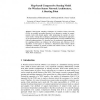Free Online Productivity Tools
i2Speak
i2Symbol
i2OCR
iTex2Img
iWeb2Print
iWeb2Shot
i2Type
iPdf2Split
iPdf2Merge
i2Bopomofo
i2Arabic
i2Style
i2Image
i2PDF
iLatex2Rtf
Sci2ools
MOBILWARE
2009
ACM
2009
ACM
Map-Based Compressive Sensing Model for Wireless Sensor Network Architecture, A Starting Point
Sub-Nyquist sampling techniques for Wireless Sensor Networks (WSN) are gaining increasing attention as an alternative method to capture natural events with desired quality while minimizing the number of active sensor nodes. Among those techniques, Compressive Sensing (CS) approaches are of special interest, because of their mathematically concrete foundations and efficient implementations. We describe how the geometrical representation of the sampling problem can influence the effectiveness and efficiency of CS algorithms. In this paper we introduce a Map-based model which exploits redundancy attributes of signals recorded from natural events to achieve an optimal representation of the signal.
Active Sensor Nodes | MOBILWARE 2009 | Operating Systems | Sub-Nyquist Sampling Techniques | Wireless Sensor Networks |
| Added | 28 May 2010 |
| Updated | 28 May 2010 |
| Type | Conference |
| Year | 2009 |
| Where | MOBILWARE |
| Authors | Mohammadreza Mahmudimanesh, Abdelmajid Khelil, Nasser Yazdani |
Comments (0)

